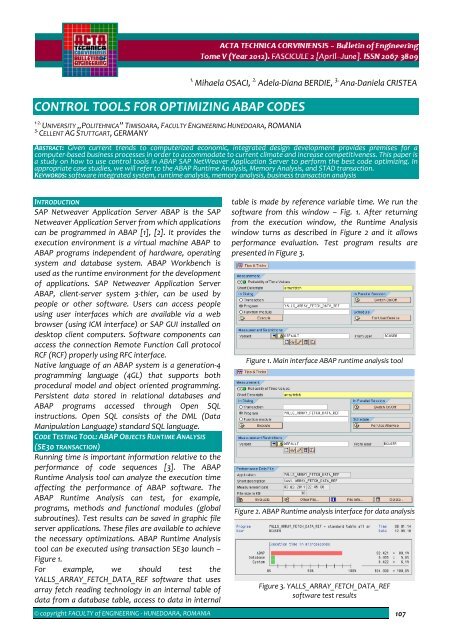Editorial & Advisory Board - Acta Technica Corviniensis
Editorial & Advisory Board - Acta Technica Corviniensis
Editorial & Advisory Board - Acta Technica Corviniensis
You also want an ePaper? Increase the reach of your titles
YUMPU automatically turns print PDFs into web optimized ePapers that Google loves.
1.<br />
Mihaela OSACI, 2. Adela‐Diana BERDIE, 3. Ana‐Daniela CRISTEA<br />
CONTROL TOOLS FOR OPTIMIZING ABAP CODES<br />
1‐2.<br />
UNIVERSITY „POLITEHNICA” TIMISOARA, FACULTY ENGINEERING HUNEDOARA, ROMANIA<br />
3.<br />
CELLENT AG STUTTGART, GERMANY<br />
ABSTRACT: Given current trends to computerized economic, integrated design development provides premises for a<br />
computer‐based business processes in order to accommodate to current climate and increase competitiveness. This paper is<br />
a study on how to use control tools in ABAP SAP NetWeaver Application Server to perform the best code optimizing. In<br />
appropriate case studies, we will refer to the ABAP Runtime Analysis, Memory Analysis, and STAD transaction.<br />
KEYWORDS: software integrated system, runtime analysis, memory analysis, business transaction analysis<br />
INTRODUCTION<br />
SAP Netweaver Application Server ABAP is the SAP<br />
Netweaver Application Server from which applications<br />
can be programmed in ABAP [1], [2]. It provides the<br />
execution environment is a virtual machine ABAP to<br />
ABAP programs independent of hardware, operating<br />
system and database system. ABAP Workbench is<br />
used as the runtime environment for the development<br />
of applications. SAP Netweaver Application Server<br />
ABAP, client‐server system 3‐thier, can be used by<br />
people or other software. Users can access people<br />
using user interfaces which are available via a web<br />
browser (using ICM interface) or SAP GUI installed on<br />
desktop client computers. Software components can<br />
access the connection Remote Function Call protocol<br />
RCF (RCF) properly using RFC interface.<br />
Native language of an ABAP system is a generation‐4<br />
programming language (4GL) that supports both<br />
procedural model and object oriented programming.<br />
Persistent data stored in relational databases and<br />
ABAP programs accessed through Open SQL<br />
instructions. Open SQL consists of the DML (Data<br />
Manipulation Language) standard SQL language.<br />
CODE TESTING TOOL: ABAP OBJECTS RUNTIME ANALYSIS<br />
(SE30 TRANSACTION)<br />
Running time is important information relative to the<br />
performance of code sequences [3]. The ABAP<br />
Runtime Analysis tool can analyze the execution time<br />
affecting the performance of ABAP software. The<br />
ABAP Runtime Analysis can test, for example,<br />
programs, methods and functional modules (global<br />
subroutines). Test results can be saved in graphic file<br />
server applications. These files are available to achieve<br />
the necessary optimizations. ABAP Runtime Analysis<br />
tool can be executed using transaction SE30 launch –<br />
Figure 1.<br />
For example, we should test the<br />
YALLS_ARRAY_FETCH_DATA_REF software that uses<br />
array fetch reading technology in an internal table of<br />
data from a database table, access to data in internal<br />
table is made by reference variable time. We run the<br />
software from this window – Fig. 1. After returning<br />
from the execution window, the Runtime Analysis<br />
window turns as described in Figure 2 and it allows<br />
performance evaluation. Test program results are<br />
presented in Figure 3.<br />
Figure 1. Main interface ABAP runtime analysis tool<br />
Figure 2. ABAP Runtime analysis interface for data analysis<br />
Figure 3. YALLS_ARRAY_FETCH_DATA_REF<br />
software test results<br />
© copyright FACULTY of ENGINEERING ‐ HUNEDOARA, ROMANIA 107

















